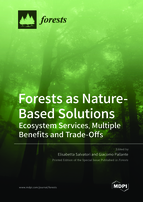Forests as Nature-Based Solutions: Ecosystem Services, Multiple Benefits and Trade-Offs
A special issue of Forests (ISSN 1999-4907). This special issue belongs to the section "Forest Economics, Policy, and Social Science".
Deadline for manuscript submissions: closed (22 May 2022) | Viewed by 26717
Special Issue Editors
Interests: nature-based solutions; ecosystem services; urban and peri-urban forests; plant functional traits; ecophysiology
Special Issues, Collections and Topics in MDPI journals
Interests: socio-economic evaluation; natural capital accounting; ecosystem services
Special Issue Information
Dear Colleagues,
Forest ecosystems, including natural forests, managed forests, agroforestry systems and urban and peri-urban forests, can be considered as multifunctional Nature-based Solutions (NbS), since they deliver key ecosystem services to people. The concept of NbS is an “umbrella” framework for several ecosystem-based approaches, categorized by the IUCN as protective (e.g., area-based conservation), restorative (e.g., ecological restoration), infrastructure-based (e.g., green infrastructure), management-based or issue-specific (e.g., ecosystem-based disaster risk reduction). All these approaches rely on biodiversity and ecosystem services to address global societal challenges, simultaneously providing environmental, social and economic benefits, and helping build resilience. NbS are becoming more and more relevant in international and European policy frameworks, such as in the EU Biodiversity Strategy 2030 and in the upcoming EU Forest Strategy. However, for the effective implementation and mainstreaming of NbS, several research gaps need to be addressed. This Special Issue welcomes studies bringing new data and methods about i) quantification of ecosystem services (regulation and maintenance, provisioning, cultural) provided by forests in natural, semi-natural and urban contexts, as well as their potential disservices; ii) monetary valuation and cost/benefit analysis of forests as NbS to sustainably address specific challenges. Original research and reviews targeted at understanding key characteristics of NbS, supporting the delivery of multiple benefits, the potential limitations and trade-offs, as well as case studies of operationalization of NbS into policy decisions, are particularly encouraged.
Dr. Elisabetta Salvatori
Dr. Giacomo Pallante
Guest Editors
Manuscript Submission Information
Manuscripts should be submitted online at www.mdpi.com by registering and logging in to this website. Once you are registered, click here to go to the submission form. Manuscripts can be submitted until the deadline. All submissions that pass pre-check are peer-reviewed. Accepted papers will be published continuously in the journal (as soon as accepted) and will be listed together on the special issue website. Research articles, review articles as well as short communications are invited. For planned papers, a title and short abstract (about 100 words) can be sent to the Editorial Office for announcement on this website.
Submitted manuscripts should not have been published previously, nor be under consideration for publication elsewhere (except conference proceedings papers). All manuscripts are thoroughly refereed through a single-blind peer-review process. A guide for authors and other relevant information for submission of manuscripts is available on the Instructions for Authors page. Forests is an international peer-reviewed open access monthly journal published by MDPI.
Please visit the Instructions for Authors page before submitting a manuscript. The Article Processing Charge (APC) for publication in this open access journal is 2600 CHF (Swiss Francs). Submitted papers should be well formatted and use good English. Authors may use MDPI's English editing service prior to publication or during author revisions.
Keywords
- Climate change mitigation and adaptation
- Air quality
- Water quality
- Recreation
- Plant functional traits
- Land-use planning
- Forest management and restoration
- Protected areas
- Monetary valuation and accounting
- Socio-economic benefits







